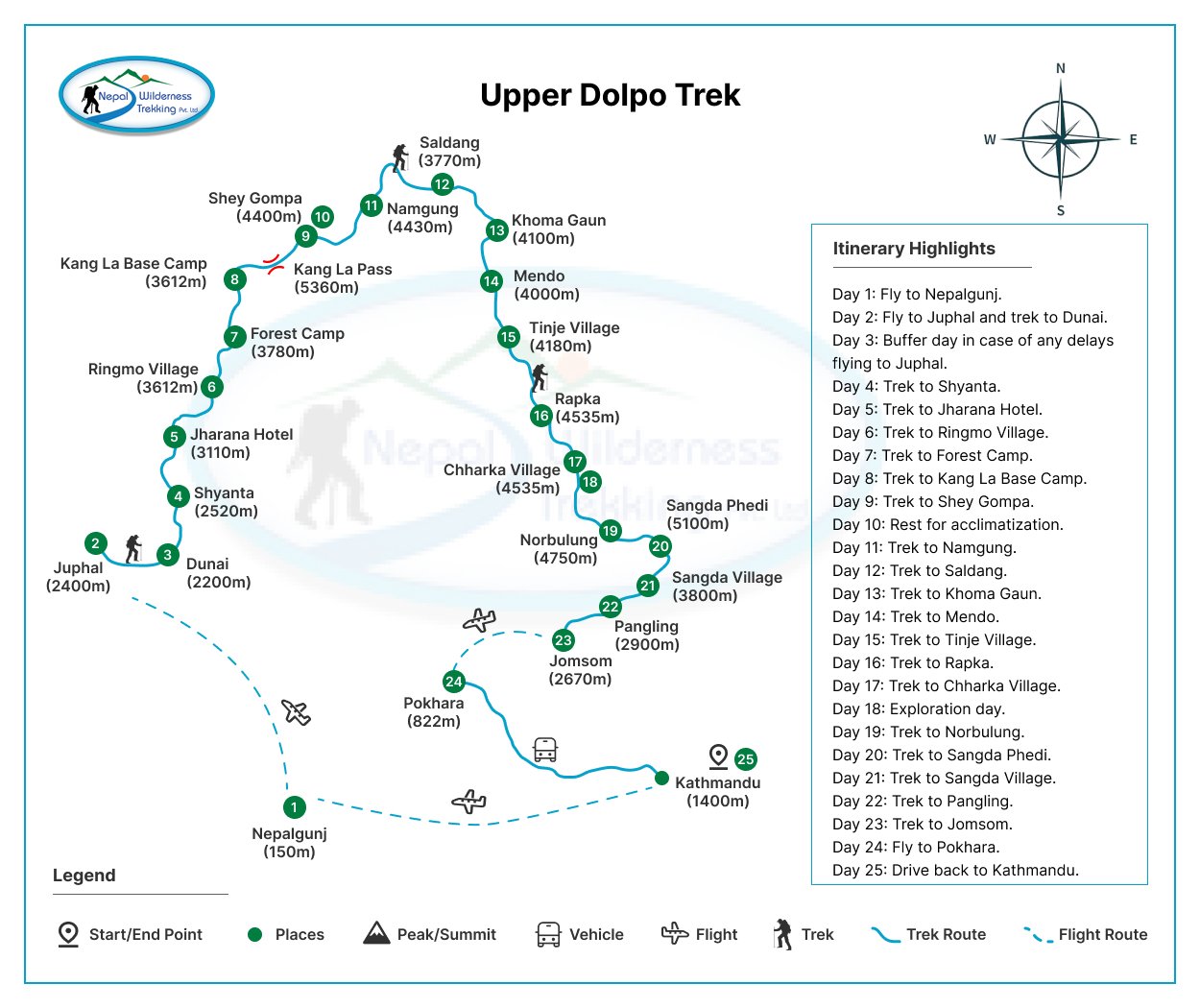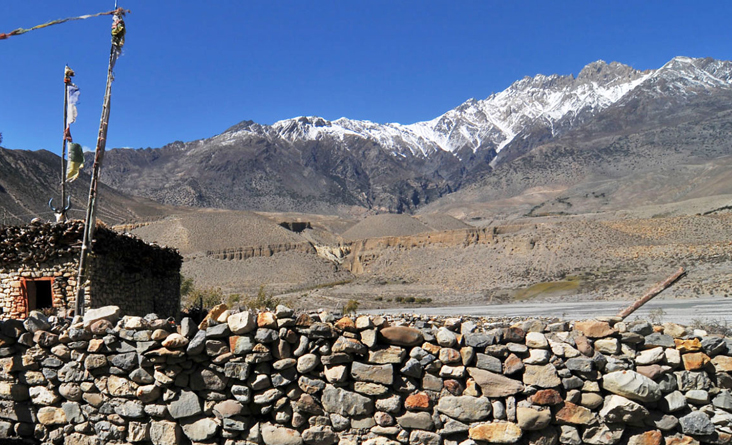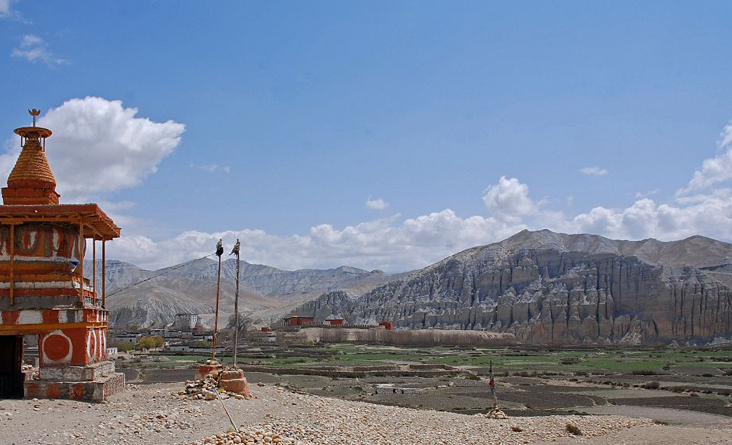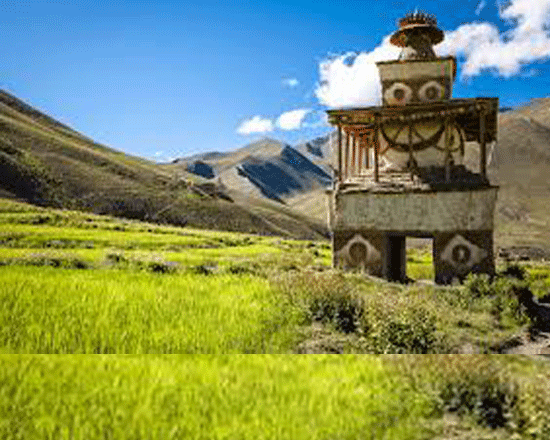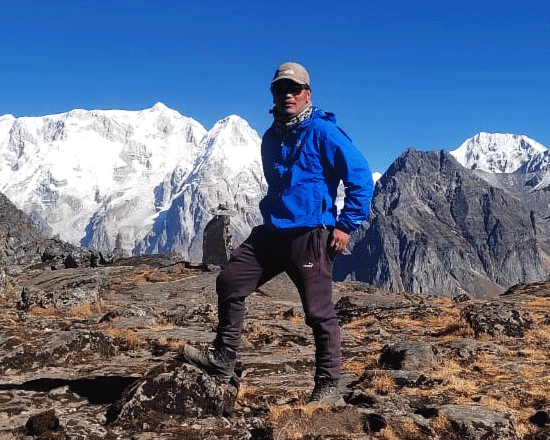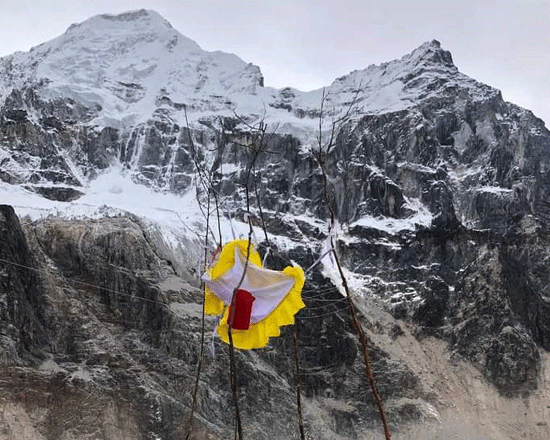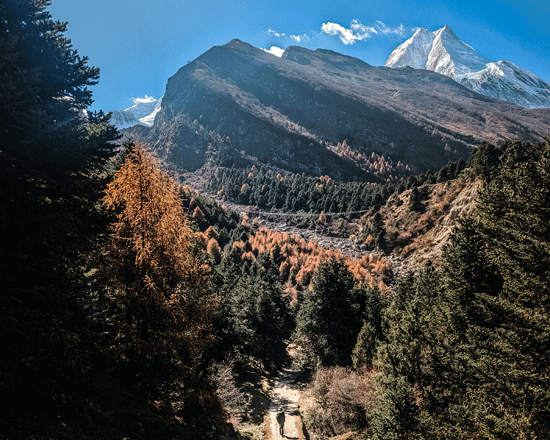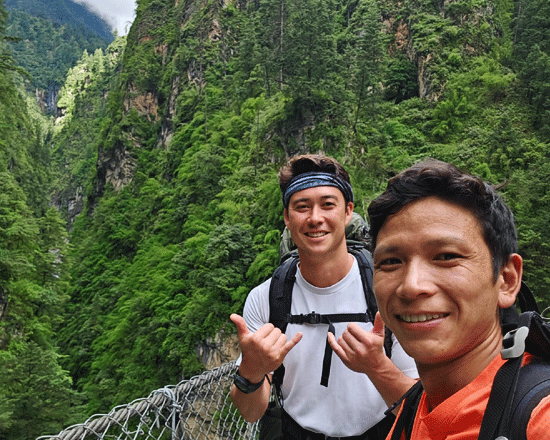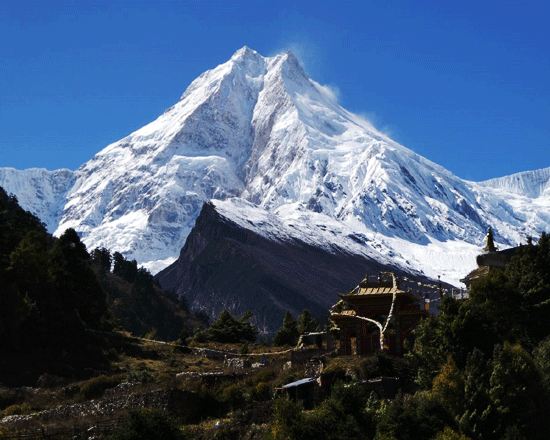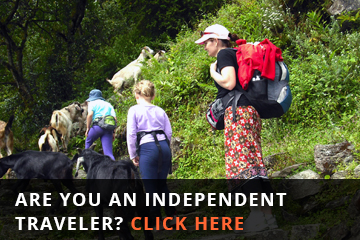Upper Dolpo Trek
Upper Dolpo Trek
Wilderness TrekkingTrip Facts
Since the terrain can be hard and the days long, hikers on these treks should be in good physical condition and have some previous mountain walking experience. Steep climbing may be involved, although it is never necessary to use ropes. Treks at this level can he arranged for periods of 16 to 21 days. Typically, a gradual ascent through a green river valley will lead you up to a number of high passes, where you will reach the altitude of 5416m. Often times, you will get a close insight into the Tibetan culture. Participants should expect to trek above 5416m/17872ft.
Mode of Travel : Flight/Land100%
Overview
The Dolpo Trek 25 days package itinerary
One of Nepal’s most mesmerizing naturally beautiful, culturally rich, and remote trekking destinations. It is also deeply influenced by Tibetan culture, Buddhism, ancient trade routes, spiritually serene high-altitude environments, geographical isolation, and unique indigenous traditions. The area has preserved its natural beauty, untouched by the waves of modernization. This makes it an essential destination for trekkers who value serenity. This trek combines the mystical landscapes of Dolpo with the ancient kingdom of Mustang.
This high-altitude region in Nepal’s far northwest, nestled between the Dhaulagiri range to the southeast and the Tibetan Plateau to the north bordering Tibet. The area is protected under Shey Phoksundo National Park. Taking you through a land often referred to as “Nepal’s Hidden Treasure” and the preservation of its unique Tibetan culture.
Its remoteness has allowed it to maintain a distinctive cultural identity while preserving many ancient traditions. Even as Dolpo opens to the modern world, it remains a place where time seems to stand still, and its history continues to shape the daily lives of the Dolpo-pa people.
History of Upper Dolpo Trek
Tibetan Buddhism, particularly the Nyingma and Kagyu schools, became the dominant spiritual force in Dolpo from around the 10th century CE. Dolpo is home to some of the oldest and most significant Buddhist monasteries in Nepal. One of the most revered is the Shey Gompa (Crystal Monastery), which dates back to the 11th century. A Buddhist sanctuary at 4,200m within the Shey Phoksundo rural municipality of Dolpa. It is said to have been established by the Tibetan lama Tenpai Nyima and remains an important pilgrimage site for Tibetan Buddhists, particularly during the Shey Pilgrimage every 12 years.
This monastery is the spiritual center of the Upper Dolpo trek. It is housed in a red two-story building decorated with detailed Buddhist artworks. In 1220 BS, the Kagyu tribe initiated a festival symbolizing triumph over evil spirits, the Rakshas. Monasteries in Dolpo are centers not only of religious life but also of cultural preservation, where ancient texts, art, and traditions have been safeguarded for generations. The presence of chortens (stupas), mani walls (stone walls carved with prayers), and prayer flags throughout the region are testimonies to the area’s deep-rooted Buddhist practices.
The religion of Dolpo, is Buddhism, the supreme dharma of Lord Buddha, who lived and practiced in India and Nepal 2500 years ago. Dolpo people have been assiduously practicing with great faith, lord Buddha’s doctrine for 2500 years. The people have been very grateful of Buddha. For being the true Buddha dharma for all this time as a reason there is no evidence any time for killing or sacrifiving of animals in the name of religion or salvation. Dolpo is believed to have come into existence after the reign of the Tibetankings Nyatri Tsenpo and Songtsen Gampo. It is important to know that even in bad times, before these kings, Tibetan itself was not a true Buddhist country. It is only after Songtsen Gampo and Trisong Detsen,that Tibet can be considered a Buddhist naton.
Great History of Being the Meditation center
According to the mythology, advanced yogis and spiritual masters have heard and seen Tigers and Lions, Hyenas and Bears and all sorts of animals in their visions because the mountains in the land of Dolpo are possessed and believed to be scared. Also everything is scared in Dolpo. Many master had foreseen the dharma protector Magyal Pomra and the twelve religious protectors of Tibet, Nyanchen Thangla, as well as the eight tribal gods, and heroes and dakinis. These great saints used to conduct pujas and make offerings to these gods here in Dolpo. And in turn, the gods return and blessed and gave support and empowerment and protect them. These traditions have been transfrred from generation to generation . And the present Lamas and Gurus in Dolpo are the embodiment of these practices.
Those people in Dolpo who’ve been practicing dharma, those saints , spend their whole lives in caves in retreat practicing Buddhist meditation. They are truly unique people. People like this are not found in other parts of the world. These people who have done retreats in Dolpo, reflect the best aspects of human nature and are known for their generosity and honesty.
Interesting Facts
About 200 years ago, every small principality in Dolpo had its own king. Howeverr, for unity and culture the people looked to Tibet. In 1779, the sixth Penchen lama Palden Yeshi, was ruling in Tibet. However, after His Holiness passed away in China, political turmoil broke out in Tibet. The Sharmapa lama, Chodup Gyatso Rimpoche was dissatifiedd with the local policies in Tibet as well as with other issues and accordingly he fled to Nepal.
Now, war broke up betwween Nepal and Tibet. The back stories is as follows, From ancient times. Nepal used to import salt salt from Tibet. But the Tibetan merchants began to adulterate this salt. Additionally, the Tibetan were making counterfelt Nepali coins, circulating them in a large quantities, thus wreaking have occurs with Nepal’s economy. Accordingly Gorkha invaded Tibet, in 1788anad foughht on untill 1791. The Nepali Gorkha troops invaded Kerong, Nyanang region of Tibet as well as Sikkim and kalingpong and Dolpo, Mugu, Lo-Monthang, Dhingiri and Tashi Lompo. All of these places were captured.
At the same time, the ministries from the government in central Tibet, the province of U-tsang, as well as Ngari, Dhege, Bha, Lithang, Gyalrong and Dhomchu Nger-Nga and other places united in their retaliatory attack on Nepal. The head of the Tibetan troops was KaLon Tashi Khangsar and he was also the master of Army. Several hundred Gorkha soldiers died in the field. However, he drove the Gorkha troops out of Tibet and recaptured some of the lost places, such as Nyanang and Zongkha. But Doplo remained within the territory of Nepal. Since 1791, Doplo and its people have became an integral part of the Nepal nation.
Mythologically speaking, some people think that the Doplo people came from birds eggs, whereas others say that they come from their mother’s womb and some say that they migrated from Tibet.
Shey Phoksundo National Park
Shey Phoksundo National Park enhances the trek’s beauty, serving as a sanctuary for rare and endangered species like snow leopards, musk deer, and blue sheep. At its heart lies the resplendent Phoksundo Lake, a turquoise towering peaks. The Upper Dolpo Trek is a difficult venture that demands robust physical fitness and prior trekking experience. The optimal period to undertake this journey is from May to October, a window of clear skies and prime trekking conditions.
Trans-Himalayan Journey: Unearthing Upper Dolpo’s Essence
The Upper Dolpo trek known as the Trans-Himalayan Trek Nepal, unfolds within mid-west Nepal. This itinerary takes you through the icy domains of the famous Shey Gompa Monastery beyond Phoksundo Lake, near Tibet. While the Lower Dolpo trek grants access to Phoksundo Lake, the Upper Dolpo trek immerses you in the spiritual core of the Dolpo Region, renowned as the Crystal Monastery. Pilgrims believe that passing through this mountain liberates one from the cycle of life and death.
A tapestry of traditional Tibetan cultures intertwined with snow leopards, blue sheep, and highland grazing yaks awaits in Upper Dolpo. The trail winds across five imposing passes: Kang La (5,380m), Saldang La (5,060m), Chharka La (5,015m), Sangda La (5,515m), and lower Sangda La (5,035m).
The Upper Dolpo Circuit trek to Jomsom itinerary integrates segments of the Great Himalayan Trail, uniting Nepal with the Tibetan border. Geographically within Nepal yet culturally reminiscent of Tibet, this region resonates with the Upper Mustang trek.
Upper Dolpo Trek Routes
Starting the Upper Dolpo Trek, you begin with a scenic flight from Kathmandu to Juphal via Nepalganj. En route, you enjoy panoramas of picturesque landscapes and vast mountain ranges. Wending through expanses and mixed woodlands, the trail guide you to Ringmo Lake, Shey Phoksundo Lake, and indigenous cultures. A spiritual haven named Gombas Monastery graces Crystal Mountain, home to semi-precious gems and historical building. As you traverse villages inhabited by devout Buddhists, the similarity of Tibetans conversing in their native tongue remains in the air. The ascent culminates in Musi Gaun, affording a glimpse of the Tibetan border before advancing toward Jomsom through the Sangda La pass (5,111 meters). This marks the beginning of the Upper Mustang Trek, the Tilicho Pass Trek, the Dhaulagiri Pass, and the Dhampus Peak Climb.
Retreats and Refuges: A Haven for Rest
Accommodations along the Upper Dolpo Trek has a basic loadging . Chharka Bhot offers only basic tea house rooms, while other locals are exclusively suited for camping. However, Dunai Bazaar, Phoksundo Lake, and Jomsom promise cozy lodgings for the Upper Dolpo. The region’s northeastern confines, Chharka Bhot is a rural village situated along the Tibetan border. The Shree Chharka Bhot Basic School is a government institution facilitating education for approximately 120 children, including those from adjacent hamlets.
A Glimpse into Local Gastronomy
Upper Dolpo’s indigenous fare includes staples like Champa, boiled potatoes, and Su Chya, as well as yak and goat meats. The region’s challenging topography denies expansive arable lands, limiting lucrative crop cultivation at such high altitudes.
Expedition with Nepal Wilderness Trekking
Our expert guides and well-equipped porters arranges the western expanse of the Dolpo trekking package. Experience this journey through our comprehensive Nepal wilderness trekking packages. Our knowledgeable guides and porters, deeply familiar with the terrain, are committed to ensuring your safety and comfort.
Physical fitness preparation
To undertake the Upper DolpoTrek, trekkers need to be physically fit. It is recommended to run for at least an hour a day for 10 to 15 days or for a month varying on your fitness level before the trek. This helps to build the individuals hiking stamina. This preparation helps in acclimatizing to the high altitudes and ensures you are ready for the demanding terrain of the trek, including the challenging ascent.
What’s crucial is a willingness to prepare physically and mentally, and to respect the demands of the environment. Proper acclimatization ensures trekkers can fully enjoy the journey, absorbing the breathtaking landscapes and immersing themselves in the local culture. Ensure that, you bring the recommended trekking equipment list. Remember, a quality trekking equipment can make your trip enjoyable, while a poor one can make it miserable.
Upper Dolpo Trek Distance
The Upper Dolpo Trek typically covers around 230-270 kilometers (about 143-168 miles), depending on the specific route taken and side trips included. This trek usually takes 18-24 days to complete. Renowned for its remote and rugged terrain with views of the Himalayas and unique cultural experiences with the local Tibetan-influenced communities.
The Bon Religion
Before the Buddhism, the Bon religion, an ancient animistic and shamanistic belief system, was practiced in Dolpo. While Bon predates Buddhism, it has continued to practice the Buddhist traditions in the region. Today, many Dolpo-pa practice a syncretic form of Bon and Buddhism, where Bon deities are worshipped alongside Buddhist rituals. Bon monasteries and practitioners are still found in Dolpo, particularly in remote areas.
Highlights of the Upper Dolpa trek
- Scenic flight to Juphal via Nepalganj from Kathmandu
- The challenging trek through the remote highest mountains
- Discover the unique lifestyle and culture of the mountain people
- Legendary Shey Gompa Monastery
- Explore majestic monasteries built over centuries
- Journey through miraculous landscapes
- A paramount highlight of the Upper Dolpo experience is the captivating Phoksundo Lake, unrivaled on the trek circuit. Plummeting to depths exceeding 1,500 feet, the lake’s cerulean waters are encircled by dense pine forests and the towering magnificence of the Himalayan skyline.
The Upper Dolpo Trek promises a unique and unforgettable adventure through one of Nepal’s most remote and culturally rich regions.
Scheduled Departure Dates
- We have several scheduled departure dates for the Upper Dolpo trek.
- Since the schedule date of your trip cannot be matched with the other groups, we also lead private trip with the guide on the same cost.
- The itinerary works very flexible meeting your demands .
- The days can be extended as of your need on the way to journey.
Detail Itinerary
- Day 01: Pick up at your hotel drive to the airport and Fly to Nepalganj Elevation 150 meters above sea level.
- Day 02: Fly to Juphal 2400m, trek to Dunai (2200m) Trekking hours: Approximately 3-4 hours. 8 kilometers.
- Day 03: Buffer day in case of any delays flying to Juphal
- Day 04: Trek to Shyanta (2520m) Trekking hours: Approximately 5-6 hours. 12-14 kilometers.
- Day 05: Trek to Jharana Hotel (3,110m) Trekking hours: Approximately 6-7 hours. 10-12 kilometers.
- Day 06: Trek to Ringmo Village (3,612m) Trekking hours: Approximately 5-6 hours. Distance: Approximately 8-10 kilometers.
- Day 07: Trek to Forest Camp (Salla Ghari) (3780m) Trekking hours: Approximately 5-6 hours. Trekking distance: Approximately 8-10 kilometers.
- Day 08: Trek to Kang La Base Camp (4,600m) Trekking hours: Approximately 6-7 hours. 10-12 kilometers.
- Day 09: Trek to Shey Gompa (4400m) via Kang La Pass (5360m) Trekking hours: Approximately 7-8 hours. Trekking distance: Approximately 12-14 kilometers.
- Day 10: Rest for acclimatization
- Day 11: Trek to Namgung (4430m) via Sela Pass (5010m) Trekking hours: Approximately 6-7 hours. Trekking distance: Approximately 10-12 kilometers.
- Day 12: Trek to Saldang (3770m) Trekking hours: Approximately 5-6 hours.Trekking distance: Approximately 8-10 kilometers.
- Day 13: Trek to Khoma Gaun (4,100m) Trekking hours: Approximately 6-7 hours. Trekking distance: Approximately 10-12 kilometers.
- Day 14: Trek to Mendo (4,000m) Trekking hours: Approximately 5-6 hours. Trekking distance: Approximately 8-10 kilometers.
- Day 15: Trek to Tinje Village (4,180m) Trekking hours: Approximately 6-7 hours. Trekking distance: Approximately 10-12 kilometers.
- Day 16: Trek to Rapka (4,535m) Trekking hours: Approximately 6-7 hours. Trekking distance: Approximately 8-10 kilometers.
- Day 17: Cross Chharka La (5,015m), trek to Chharka Village (4,110m) Trekking hours: Approximately 7-8 hours. Trekking distance: Approximately 12-14 kilometers.
- Day 18: Exploration day at Chharka village
- Day 19: Trek to Norbulung (4,750m) Trekking hours: Approximately 6-7 hours.Trekking distance: Approximately 10-12 kilometers.
- Day 20: Cross Higher Sangda La (5,185m), trek to Sangda Phedi (5,100m)
- Trekking hours: Approximately 7-8 hours. Trekking distance: Approximately 12-14 kilometers.
- Day 21: Cross Lower Sangda La (5,035m), trek to Sangda Village (3,800m) Trekking hours: Approximately 6-7 hours. Trekking distance: Approximately 10-12 kilometers.
- Day 22: Trek to Pangling (2,900m) Trekking hours: Approximately 6-7 hours. Trekking distance: Approximately 10-12 kilometers.
- Day 23: Trek to Jomsom Trekking hours: Approximately 7-8 hours. Trekking distance: Approximately 12-14 kilometers.
- Day 24: Fly to Pokhara overnight at Pokhara,
- Day 25: Tourist bus to Kathmandu 6-hour drive, drop to your hotel.
Cost Included
- All land transfer and flight tickets, ktm- Juphal, Jomsom- Pokhara.
- Pokhara to ktm by tourist bus.
- National Park permits TIMS permits and special Upper Dolpo permits fees.
- Tent Accommodation and three times meals a day during the trekking.
- Fully escorted trek with fluent English-speaking license holder local Sherpa Guide and necessary porters.
- All programs are according to the itinerary on full board.
- Wages, equipment, insurance, and other facilities to staff.
Cost Excluded
- Hotel in Kathmandu
- Travel Insurance (which is covering helicopter rescue ).
- Medical evacuation in case of emergency.
- Personal expenses.
- All bar bill.
- Items of personal nature, i.e., Soft/hard drinks, tips, etc.
Trip Map
